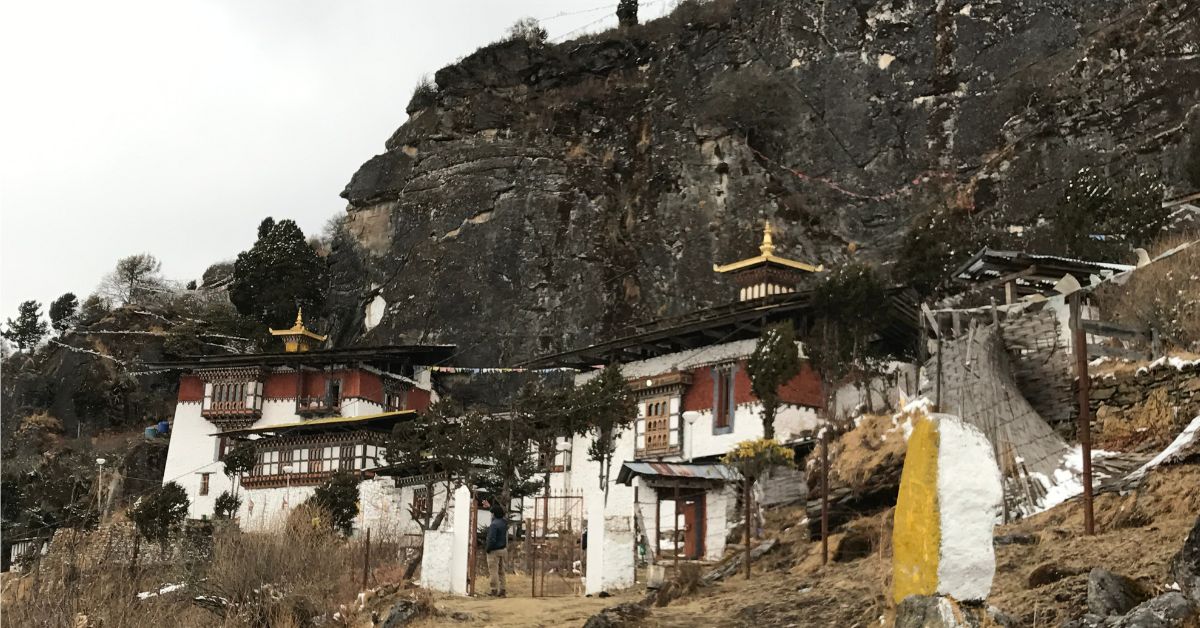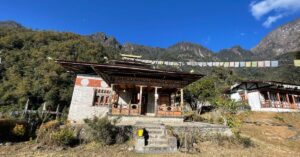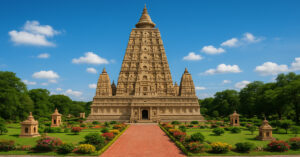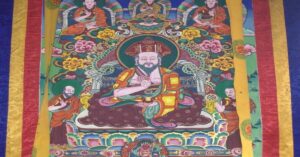Choedrak is one of the Four Cliffs (Dra Zhi) of Guru Rinpoche on the northern ridge dominating the whole Chumey valley of Bumthang Dzongkhag at an altitude of 3,800 meters. Guru Rimpoche is said to have arrived at the sacred Choedrak riding on a tigress and meditated there just like he did in Paro Taktsang.
Later, a monastery was built against the cliff by Gyalwa Lorepa, a Drukpa Kagyupa lama from Tibet in the 12th century.
However, the sacred site of Choedrak became popular only in the 18th century when the great Drukpa monk Ngawang Thrinley from Punakha rebuilt the monastery. Though the site is Choje Drak, it is popular as Choedrak.
Choedrak Monastery is one of the Four Cliffs (Dra Zhi) of Guru Rinpoche in Bumthang Valley. The other three cliffs are Shukdrak in Choekhor, Kunzangdrak, and Thowadrak in Tang Valley under the Bumthang in central Bhutan.
How to Reach Choedrak Monastery
Choedrak Monastery or Choje Drak Goenpa is 37 kilometers from Chamkhar town and a one-hour steep climb from the motorable road ending at Tharpaling monastery. Choedrak Goenpa can also be reached via a three-hour hike through a deep forest and over a pass from Lamey Goenpa in Choekhor Valley.
Sacred Relics to See at Choedrak Goenpa
- A sacred cliff where Guru Rinpoche meditated;
- Imprints of Guru and his tigress;
- Stone throne of Guru Rinpoche;
- Sacred Stone with the footprint of Khandrom;
- Sacred Khandro Dorje Yudronma’s Drupchu
- Kudung Chorten of Geshe Tempa Rinchen.
Also Read: Guru Rinpoche in Bhutan: His Visits to Bhutan and Sacred Sites
Historical Significance of Choedrak
Guru Rinpoche is said to have arrived on a tigress from Paro Taktsang and meditated at the big rock cliff on the northern ridge dominating the whole Chumey valley at an altitude of 3,800 meters, not far from Tharpaling Monastery in Bumthang District in the 8th century.
Later, Choedrak Goenpa was built against this cliff face by Onrey Dharma Singye, alias Lorey Drakpa Wangchuk or simply Lorepa, a chief disciple of Tsangpa Jaray Yeshi Dorji from Tibet in 1234.
Lorepa resided at the monastery until he returned to Tibet. Before his departure, it is said that Gyalwa Lorepa had meditated at the sacred cave for about 22 years. After Lorepa departed from Choedrak, the Lhakhang was said to have been besieged by evil spirits and was in ruins. Nobody considered approaching the site until the 18th century, when the great Drukpa monk Ngawang Trinley from Siula in Punakha exorcised the demon and rebuilt the monastery.
The sacred cliff of Choedrak is also considered the residence of the deity Dorji Yudonma, one of the twelve protectresses of the Himalayan Buddhist world. A holy water known as Yudronmai Drupchu flows out from the bhaga of Dorji Yudronma. This water has great auspicious qualities.
Also Read: Drupchhu or Holy Spring Waters in Bhutan: Beliefs and Benefits
Description of Choedrak
There are imprints of Guru Rinpoche and his tigress on the rocks as evidence of his visit to Choedrak. The meditation cave also justifies his arrival. Its exterior looks like a pile of religious texts. Inside, hanging objects look like religious items. Based on this, it is called Choe Drak. Another version says that Choeje Lorepa made this cave his religious seat, thus earning the name Choeje Drak.
There are three stone thrones considered Choelongtrul Sum. The one at the top is said to be of Sangay Yepamey, the middle is of Chenrezig, and the bottom is of Guru Rinpoche. There’s a plain ground below the throne of Guru Rinpoche, where it is said that Khandroms have offered the songs as a gesture of gratitude for the Guru’s doctrine.
A white cliff is said to be the meditation cave of Phadampa Sangye, marked at its base with his footprint. There is a prominent imprint of a sacred elephant. The origin dates back to when Phadampa arrived from India as an elephant.
Adjacent to an elephant’s trunk is a golden-painted wall believed to be the door to the holy site of Guru Rinpoche. It is thought that religious pilgrims have heard the religious sounds from that door in the past. Pilgrims still listen in the hope of hearing the religious sound once in their lifetime.
At the very top of the elephant imprint is the stone throne of Guru Rinpoche, while below it is the self-arisen conch among so many amazing imprints.
Above all, a stone believed to have the footprint of Khandrom is carried on one’s shoulder while circumambulating the Kudung Chorten three times. It is believed to cleanse our bodily sins.
Choedrak Monastery
There are two main temples at Choedrak. The main temple, or the Drupkhang, is built against a massive cliff face. The main relics (Nangtens) are statues of Kagyud lineage masters constructed by the 4th Je Khenpo Damchoe Pekar. Attached to the Drupkhang is a stone Chorten said to have been offered to Guru Padmasambhava by the Serpent King.
Almost centrally, there is a Kudung Chorten of Geshe Tempa Rinchen at the sacred monastery.
Several traditional Bhutanese structures are built around the meditation caves. Choedrak Monastery is mostly a hermitage used by religious masters and monks for retreats and solitary life. Above Choedrak Monastery is a meditation cave of Longchenpa and a rock throne, where Longchenpa wrote part of the Seven Treasures.
Choeje Drak was under the administration of Punakha Dratshang and appointed a Lam with the title Choedrak Lam. During the appointment ceremony of Chogyal Minjur Tenpa as the Trongsa Penlop, three Lams (Choedrak Lam, Rigsum Goenpa Lam, and Yongla Goenpa Lam) were also appointed from Trongsa Rabdey. Since then, it has become customary to appoint these Lams from Trongsa Rabdey.
Also Read: Dra Zhi, the Four Great Meditation Cliffs of Guru Rinpoche in Bumthang
Drangsong Latsho
If you have time, visit a lake. The lake is known as Drangsong Latsho and is located an hour’s walk from Choejedrak at the base of the cliff. It is said that the Latsho is associated with the deity Drangsong. Legend says that while Kunkhyen Longchen Rabjam stayed at Samtenling, the protective deity Drangsong would herd Kunkhyen Longchen Rabjam’s horses daily. As the horses freely roamed in the pasture, Drangsong would go to the Latsho, where he would withdraw religious artifacts from the Latsho, play with them all day, and then return home with the horses in the evening.
While Drangsong was distracted, the horses would often roam about and destroy the crops of nearby Getsa village. This caused the crop owners to complain to Kunkhyen about his horses destroying their crops.
One day, Kunkhyen Longchen Rabjam decided to check up on Drangsong and followed him to the pasture site. Kunkhyen was surprised to see that after Drangsong had sent the horses to roam freely, he had pulled objects from Latsho to play with them. When Drangsong spotted Kunkhyen, he threw everything back into the Latsho. However, Kunkhyen retrieved the Boerol (cymbal) and the bronze khor (pot), now preserved at Samtenling Lhakhang.
Best Time to Visit Choedrak Monastery
Choje Drak is considered a year-round destination. However, to avoid monsoons, the best time of the year to travel is still considered Spring and Autumn. The spring season runs from March to May, and the autumn season runs from September to November. It is the time of year for flowers, pleasant weather, and warm temperatures. You can visit the major pilgrimage sites of Bumthang with the Bhutan Pilgrimage Package.
Enjoyed reading this blog?




